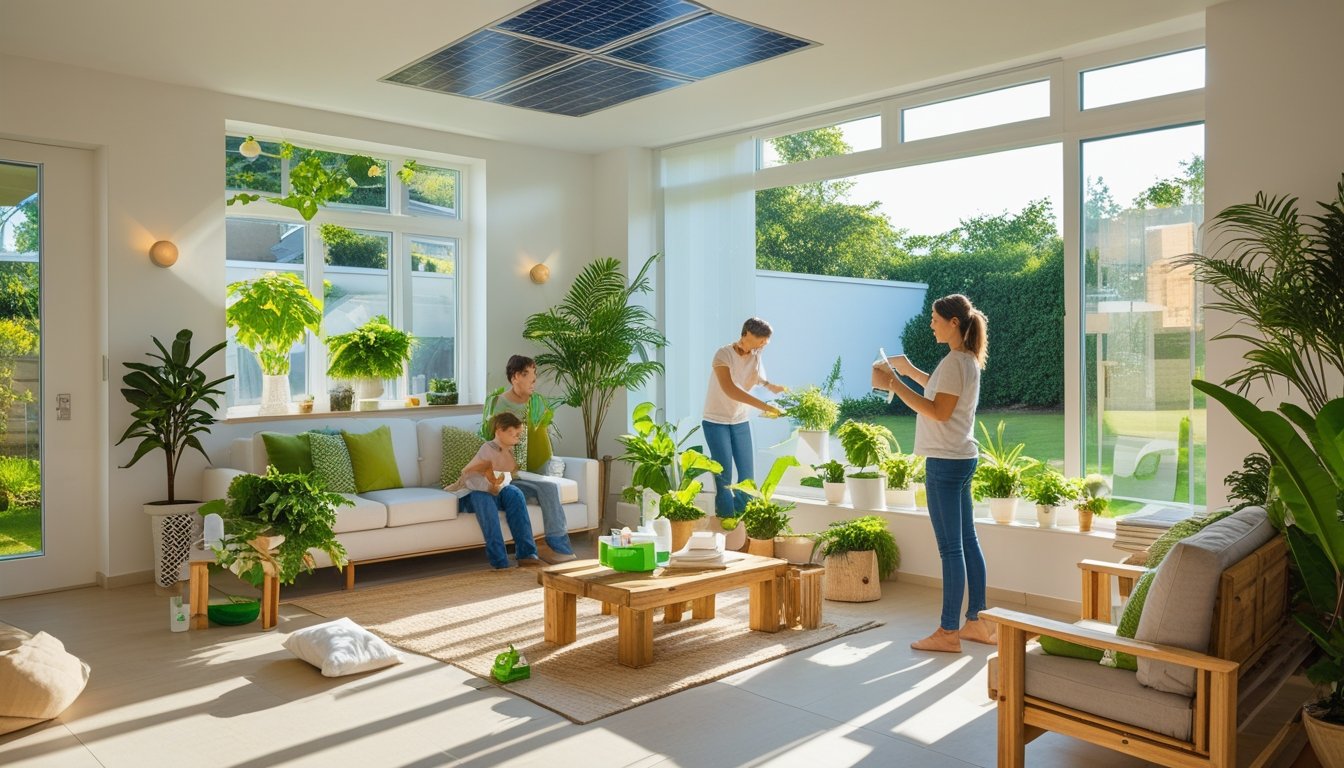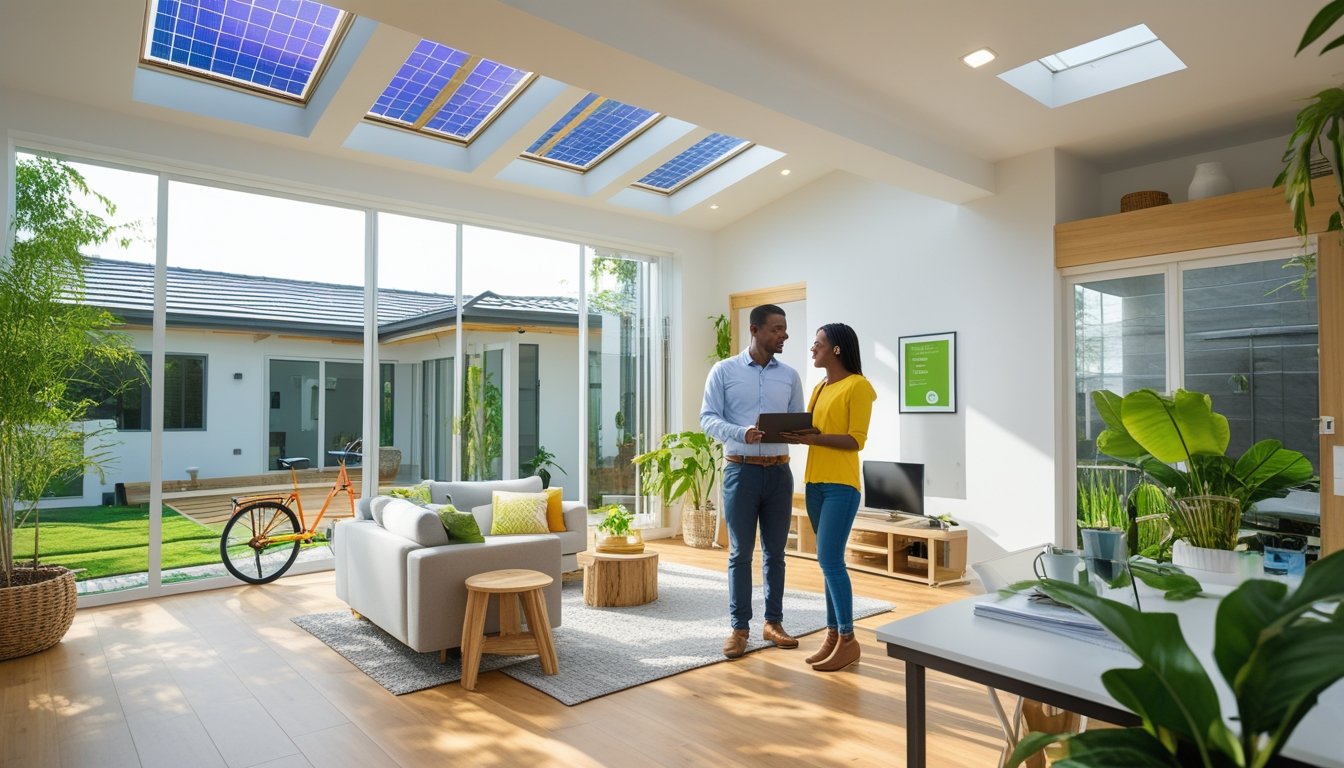Late updated: 11 Aug 2025 11:08
Written by: Sarah Hollister
Sustainable Tips For Eco-Friendly Home Improvements: Transform Your Living Space
Creating an eco-friendly home doesn't just benefit the environment; it can also enhance our quality of life and potentially increase property value. From using renewable resources to adopting energy-efficient designs, sustainable improvements are making homes more comfortable and cost-effective. Incorporating solar panels, energy-efficient appliances, and water-saving systems are direct routes to transforming our living spaces into greener havens.

As we look at sustainable tips for home improvement, we encounter a variety of options that cater to different lifestyles and budgets. Whether it's a small change like using eco-paints or a significant investment like installing green roofs, these choices not only reduce our carbon footprint but also align our living spaces with modern eco-standards. Exploring these options, we gain insights that make our homes sustainable and future-ready.
Understanding the incentives and certifications associated with eco-friendly improvements can also enhance decision-making. These aspects are crucial for individuals aiming to link sustainability with economic benefits. By embracing lifestyle changes and recognised certifications, we can maximise both our environmental impact and financial returns.
Key Takeaways
- Eco-friendly improvements enhance property value and lifestyle.
- Various sustainable options cater to different budgets.
- Incentives and certifications amplify economic benefits.
Essential Sustainable Tips For Eco-Friendly Home Improvements
When renovating our homes with sustainability in mind, it's crucial to focus on increasing energy efficiency, implementing renewable energy solutions, using sustainable materials, and optimising water conservation with smart home features. Each of these aspects can make a significant impact on reducing our environmental footprint.
Increase Energy Efficiency and Reduce Your Carbon Footprint
Improving our home's energy efficiency is a vital step in reducing our carbon footprint. Installing energy-efficient appliances is an effective way to achieve this. Look for products with the Energy Star label. These appliances consume less energy and often work more effectively.
A programmable thermostat can also be a significant game-changer. It allows us to control indoor temperatures efficiently, conserving energy by operating at optimal times. Not only does this reduce energy usage, but it can also lead to substantial energy savings over time.
Lastly, incorporate smart home technology. By using smart appliances, we can monitor and track energy consumption, making it easier to identify areas for improvement.
Implement Renewable Energy Solutions
Adopting renewable energy sources is key in transforming our homes into eco-friendly spaces. Solar panels are one of the most effective solutions. They convert sunlight into electricity, dramatically reducing reliance on non-renewable energy.
Solar panels work well with an efficient battery storage system, enabling us to store excess solar energy for use when the sun isn’t shining. This setup provides us greater control over our energy consumption, promoting both energy independence and sustainability.
Additionally, consider the potential for green roofs, which help regulate temperature and reduce heating and cooling costs.
Use Sustainable and Recycled Materials
Selecting sustainable materials is essential for any eco-friendly renovation. Opting for recycled materials not only conserves resources but also reduces the environmental impact. Reclaimed wood is an excellent choice for flooring or furniture. It offers elegance while lessening the demand for new timber.
Incorporate materials that improve indoor air quality. By using low-VOC products, we can ensure a healthy environment for inhabitants.
For those seeking LEED certification for their home improvements, using these sustainable materials can significantly contribute to achieving energy and environmental design benchmarks.
Optimise Water Conservation and Smart Home Features
Water conservation is a crucial element of sustainable home improvements. Installing low-flow faucets and showerheads with the WaterSense label can significantly cut down on water usage without compromising performance.
A dual-flush toilet is another innovative feature that allows for water-saving options in bathroom design. Coupling this with a tankless water heater ensures hot water is on-demand, reducing unnecessary heating.
Moreover, consider a rainwater harvesting system. This allows us to collect and store rainwater for purposes like irrigation, reducing dependency on municipal water supplies, and promoting wise water management.
By making these targeted improvements, we can create homes that are both environmentally responsible and economically beneficial.
Maximising Incentives, Certifications, and Lifestyle Benefits

Incorporating sustainable features into home renovations provides financial advantages through incentives and enhances overall quality of life. Utilising recognised eco-certifications can further optimise energy usage and promote environmental stewardship.
Leverage Grants, Rebates, and Tax Credits
We can take advantage of various financial incentives designed to encourage eco-friendly home improvements. Grants, rebates, and tax credits play critical roles in reducing the initial costs of sustainable renovations. For instance, government programmes often offer rebates for energy-efficient appliances or the installation of solar panels.
Tax credits can also be significant. In many regions, these credits are available for broader steps, such as comprehensive energy efficiency upgrades. By navigating these options, eco-conscious homeowners can significantly lower their expenses.
Grants are another avenue worth exploring, especially for more extensive eco-renovation projects. While they might require some legwork, the financial benefits can be considerable. Through careful research and application, we ensure our sustainable living plans are both economical and eco-conscious.
Prioritise Certifications and Eco Labels
When tackling sustainable home improvements, prioritising materials and appliances with credible certifications and eco labels is crucial. LEED and Energy Star are examples of well-regarded labels that indicate a product's environmental impact and efficiency.
The WaterSense label is also vital, specifically for water-saving fixtures within the home. These certifications not only assure quality and environmental friendliness but can also contribute to higher property values.
With these trusted markings, we confidently select products that align with our commitment to eco-friendly home improvements. Moreover, incorporating such certified products often qualifies for additional rebates or incentives, further enhancing our renovation's financial feasibility.
Enhance Indoor Air Quality and Environmental Footprint
Eco-friendly home improvements often lead to better indoor air quality and reduced environmental footprint. By using low-VOC (volatile organic compound) paints and materials, we eliminate harmful chemicals from our living spaces, promoting a healthier indoor environment.
Introducing plants and improving ventilation can amplify these benefits, ensuring our homes maintain excellent air quality. Sustainable renovations such as energy-efficient windows and improved insulation don't just lower utility bills—they also help in reducing our overall carbon footprint.
Focusing on both health and sustainability ensures that our homes become better places to live while contributing to wider environmental well-being. By prioritising these elements, we align our lifestyle benefits with eco-conscious goals.
Frequently Asked Questions

In our exploration of sustainable home improvements, numerous important considerations emerge. Key areas of focus include innovative ways to conserve energy, effectively manage natural resources like rainwater, and assess the sustainability of materials utilised in construction and renovation.
What are the most effective insulation materials to reduce energy consumption at home?
Choosing proper insulation can significantly decrease energy use. Materials like cellulose made from recycled paper, sheep’s wool, and rigid foam can offer efficient thermal barriers. They help maintain indoor temperatures, reducing reliance on heating and cooling systems.
How can rainwater be efficiently harvested and utilised in domestic settings?
Rainwater harvesting systems can be practical and efficient. By installing gutter systems and storage tanks or barrels, we can collect and store rainwater for non-potable uses such as irrigation or flushing toilets. This conserves water and reduces utility bills.
What are the best renewable energy sources for residential installations?
Solar panels and small-scale wind turbines are popular residential renewable energy options. Solar panels convert sunlight into electricity or heat, while wind turbines can generate electricity by harnessing wind energy. Both reduce dependence on traditional energy sources.
What steps can homeowners take to ensure their renovation projects minimise waste?
Minimising waste during renovations involves planning diligently. Repurposing materials, donating unused items, and choosing suppliers who prioritise sustainable practices can help in reducing a project’s waste. Efficient planning should aim to maximise material use and recycle whenever possible.
Could you suggest eco-friendly alternatives to traditional heating systems?
Heat pumps and solar water heaters are efficient, eco-friendly alternatives. Heat pumps transfer warmth from external sources into the home, while solar water heaters use sunlight to produce hot water. Both systems reduce greenhouse gas emissions and energy consumption.
How can one evaluate the sustainability of building materials before purchase?
Evaluating building materials involves examining their life cycle costs and impacts. Certifications like FSC for wood products, or Cradle to Cradle for various materials, can provide assurance of sustainability. Additionally, materials sourced locally tend to have lower transportation impacts, further enhancing their sustainability.
